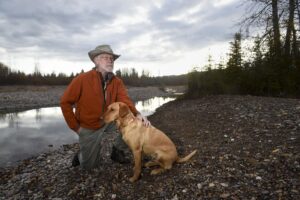
Fishing’s mostly about figuring out things in opposition. It’s too sunny, too deep, too windy. Stick with it, you realize that’s the way it is, always. And poof! Obstacles vanish. That’s a bit like how Paul Roos emerged as Montana’s most influential outfitter and fly fishing conservationist.
In recalling Paul’s approach to tangled environmental issues to Big Sky Journal in 2018, friend Becky Garland surmised, “Tough issues didn’t seem so tough when Paul was in the room.” As a student at Carroll College, and during his first years teaching, the Helena native spent summers in West Yellowstone under the tutelage of outfitter Pat Barnes, a fellow teacher. “Pat turned me on to fishing outfitting and taught me that conservation and good business go hand-in-hand,” Paul told a reporter.
In 1969, Paul returned to Lincoln with a growing family to become the Lincoln School principal. He’d spend summers as a Blackfoot River fishing guide. That endeavor became Paul Roos Outfitters, which eventually acquired a reputation as a Blackfoot Valley restoration think tank.
In 1975, a dam burst on the Blackfoot River headwaters, spilling 100,000 tons of toxic mine tailings into the river. Montana Fish & Game ended stocking rivers in 1974, so the catastrophe in part exposed why wild trout didn’t return to the Blackfoot as expected. Paul recognized the considerable challenges the river faced: Mining, antiquated irrigation, logging, grazing, and overfishing among them.
In 1986, when the Sunshine Mining Company proposed an open-pit gold mine downstream of Lincoln, Paul and others got busy. He helped form the Big Blackfoot Chapter of Trout Unlimited to focus on restoring wild trout by working with landowners and public agencies. Since 1987, BBCTU and more than 200 landowners have completed 700 projects ranging from stream restoration to grazing management. In the middle Blackfoot River, native trout numbers increased 800 percent. Poof!
One mended ranch led to another, which led to the creation of the Blackfoot Challenge in 1993. Paul helped the nonprofit include mining and timber companies, state and federal agents, ranchers, recreationists, guides, outfitters, local businesses, and landowners. Today, the Blackfoot Challenge’s ridge-to-ridge collaboration is a national model for preserving a watershed’s rural character and natural setting.
Paul helped found the Fishing Outfitters Association of Montana; served as a director of the Clark Fork Coalition, on the Advisory Council for Private Lands/Public Wildlife; and co-chaired the Lincoln Forest Restoration Committee. In the late 1990s, Paul was part of a group that stopped a gold mine development at the Blackfoot River headwaters and championed a voter initiative that ended cyanide-heap leach mining in Montana. He helped create Lincoln’s outdoor sculpture garden, Blackfoot Pathways: Sculpture in the Wild, and helped establish the Lincoln Community River Park.
Paul passed after a brief illness in November 2020, with his wife, Bonnie, and his daughters Kathie, Paula, Shomai, and Lee by his side at his home in Lincoln.
By Tom Palmer, Montana Outdoor Hall of Fame
The Missoula Conservation Roundtable gratefully acknowledges generous contributions to our website design. Our logo was created by Kate Davis, Raptors of the Rockies; Brian Christianson contributed the photographs for page headers Brian Christianson Photography
Website created by Irestone Web Design
